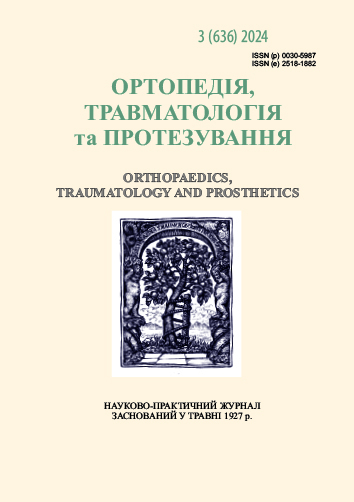Оutcome of neglected posterior elbow dislocation with gross ligamentous instability by arthrolysis combined with circumferential reconstruction of MCL, LUCL using triceps tendon fascia
DOI:
https://doi.org/10.15674/0030-59872024322-27Keywords:
Elbow joint, dislocation, obsolete, instability, reconstructionAbstract
Dislocation of the elbow joint, which has not been treated for more than 3 weeks, is considered outdated. Due to the high risk of complications and the uncertainty of the effectiveness of the treatment of an old dislocation of the elbow joint, it is quite a difficult task for surgeons. There are various described techniques for repairing the lateral ligamentous complex (including the LUCL) and the medial collateral ligament. Objective. To describe the author's unique technique, which consists in using one graft to restore both lateral and medial ligaments. Methods. The personal experience of treating 14 patients with chronic dislocation of the elbow joint with deformation and multidirectional instability is presented. All patients were operated on by one surgeon using the arthrolysis method in combination with MCL, LUCL reconstruction using an ipsilateral autograft of the triceps tendinous fascia. Further observation was carried out at 3, 6 and 12 weeks, as well as at 6 and 9 months. In our case, we evaluated stability, range of motion, and the presence of pain syndrome. The results. Satisfactory results were obtained in terms of pain-free full range of motion and adequate stability of the elbow joint in all cases. All patients performed their active routine exercise with minimal limitation. Conclusions. The advantage of the technique is a unique comprehensive approach that uses one circular graft to restore both the lateral and medial ligament complexes, which ensures stability and possible early rehabilitation. This leads to an excellent functional result — a quick restoration of the full range of motion in the joint and its stability.
References
- Kuhn, M. A., & Ross, G. (2008). Acute elbow dislocations. The Orthopedic clinics of North America, 39(2), 155–v. https://doi.org/10.1016/j.ocl.2007.12.004
- Andrew, H. C. (2017). Old unreduced dislocations. Campbell's operative orthopaedics, 61, 3155e9.
- Morrey, B. F. (2000). Chronic unreduced elbow dislocations. The Elbow and Its Disorders, ed, 4, 463-471.
- van Riet, R. P., Bain, G. I., Baird, R., & Lim, Y. W. (2006). Simultaneous reconstruction of medial and lateral elbow ligaments for instability using a circumferential graft. Techniques in Hand & Upper Extremity Surgery, 10(4), 239-244.
- Arafiles, R. P. (1987). Neglected posterior dislocation of the elbow. A reconstruction operation. The Journal of Bone & Joint Surgery British Volume, 69(2), 199-202.
- Morrey, B. F., Tanaka, S., & An, K. N. (1991). Valgus stability of the elbow: a definition of primary and secondary constraints. Clinical Orthopaedics and Related Research (1976-2007), 265, 187-195.
- Van der Ley, J., Van Niekerk, J. L., & Binnendijk, B. (1987). Conservative treatment of elbow dislocations in adults. The Netherlands Journal of Surgery, 39(6), 167-169.
- Lyons RP, Armstrong A. Chronically unreduced elbow dislocations. Hand Clinics. 2008 Feb 1;24(1):91-103.
- Morrey, B. F., & An, K. N. (2008). Functional evaluation of elbow. Elb Its Disord. In : (p. 88). Saunders WB.
- Di Schino, M., Breda, Y., Grimaldi, F. M., Lorthioir, J. M., & Merrien, Y. (1990). Surgical treatment of neglected elbow dislocations. Report of 81 cases. Revue de Chirurgie Orthopedique et Reparatrice de L'appareil Moteur, 76(5), 303-310.
- Nestor, B. J., O'driscoll, S. W., & Morrey, B. F. (1992). Ligamentous reconstruction for posterolateral rotatory instability of the elbow. JBJS, 74(8), 1235-1241.
- Sanchez-Sotelo, J., Morrey, B. F., & O’driscoll, S. W. (2005). Ligamentous repair and reconstruction for posterolateral rotatory instability of the elbow. The Journal of Bone & Joint Surgery British Volume, 87(1), 54-61.
- Eygendaal, D. (2004). Ligamentous reconstruction around the elbow using triceps tendon. Acta Orthopaedica Scandinavica, 75(5), 516-523.
- Speed, J. S. (1925). An operation for unreduced posterior dislocation of the elbow. South Med J, 18(3), 193-197.
- Billett, D. M. (1979). Unreduced posterior dislocation of the elbow. Journal of Trauma and Acute Care Surgery, 19(3), 186-188.
- Naidoo, K. S. (1982). Unreduced posterior dislocations of the elbow. The Journal of Bone & Joint Surgery British Volume, 64(5), 603-606.
- Fowles, J. V., Kassab, M. T., & Douik, M. O. N. G. I. (1984). Untreated posterior dislocation of the elbow in children. JBJS, 66(6), 921-926.
- Sahu, SK, Sahu C & Kar D. (2024) Comparing Lateral Versus Both Medial and Lateral Percutaneous K-Wire Fixation of Displaced Supracondylar Humerus Fracture in Paediatric Patients. International Research Journal of Multidisciplinary Scope, 5(2), 52-58.
Downloads
How to Cite
Issue
Section
License
Copyright (c) 2024 Сантош Кумар Саху, Ніхар Ранжан Мішра, Чінмай Саху, Даттатрея Кар

This work is licensed under a Creative Commons Attribution 4.0 International License.
The authors retain the right of authorship of their manuscript and pass the journal the right of the first publication of this article, which automatically become available from the date of publication under the terms of Creative Commons Attribution License, which allows others to freely distribute the published manuscript with mandatory linking to authors of the original research and the first publication of this one in this journal.
Authors have the right to enter into a separate supplemental agreement on the additional non-exclusive distribution of manuscript in the form in which it was published by the journal (i.e. to put work in electronic storage of an institution or publish as a part of the book) while maintaining the reference to the first publication of the manuscript in this journal.
The editorial policy of the journal allows authors and encourages manuscript accommodation online (i.e. in storage of an institution or on the personal websites) as before submission of the manuscript to the editorial office, and during its editorial processing because it contributes to productive scientific discussion and positively affects the efficiency and dynamics of the published manuscript citation (see The Effect of Open Access).














